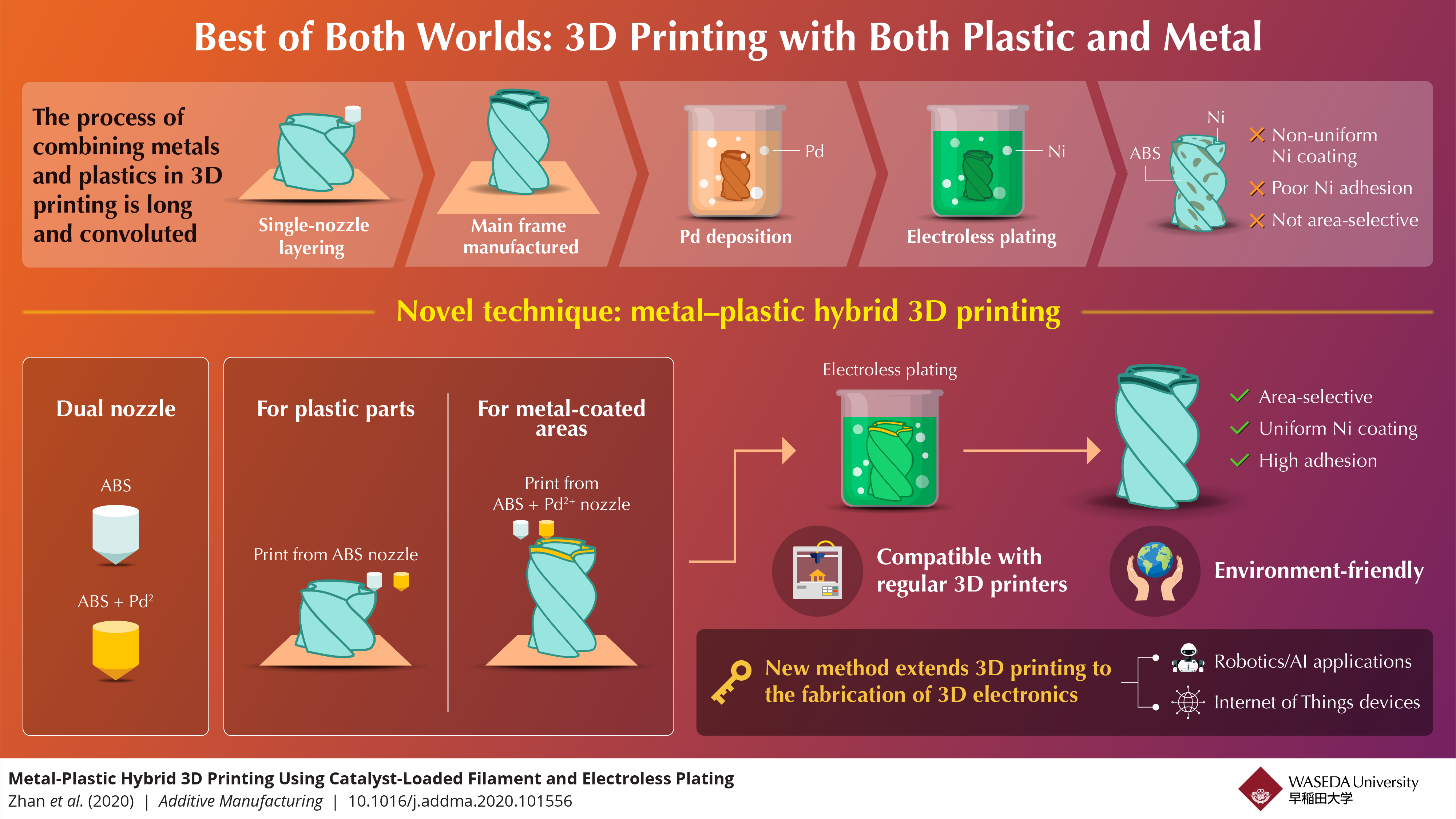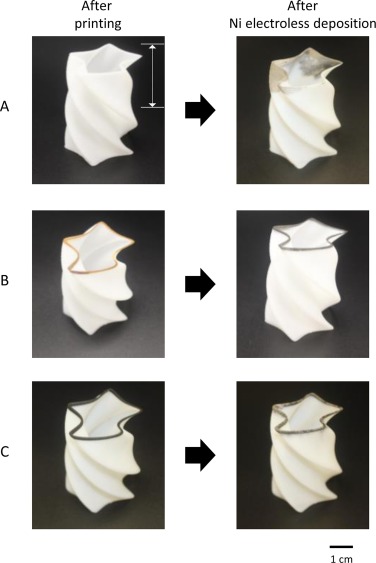Until now, metal and plastic additive manufacturing technologies have been incompatible with each other because their melting points are very different. Moreover, current 3D printers employ either plastic or metal only, and the conventional method to metal coat 3D plastic structures is not environment-friendly and yields poor results. Now, researchers at Waseda University in Japan have developed a novel and simple method to 3D print structures made of both metal and plastic thanks to a custom-made thermoplastic and commercially available fused filament fabrication (FFF) printer. This new hybrid 3D printing technique could extend the use of 3D printers to 3D electronics for future robotics and Internet-of-Things (IoT) applications.
According to a study published in the journal Additive Manufacturing, a group of scientists led by Shinjiro Umezu, Professor at Waseda University’s Department of Modern Mechanical Engineering, created a new technology capable of metalizing selected areas of 3D printed plastic structures. The 3D structure was manufactured using a dual extrusion Ultimaker S3 3D printer. One nozzle extruded the standard melted plastic acrylonitrile butadiene styrene (ABS), whereas the other nozzle extruded a custom-fabricated ABS filament loaded with the precious metal catalyst palladium chloride (PdCl2).
By selectively printing layers using one nozzle or the other, the team was able to use a conventional pure ABS filament to manufacture the main structure of the workpiece, while specific areas of the 3D object were loaded with Pd. Then, the 3D printed structure was directly immersed in a nickel electroless plating bath to coat the metal over the selected 3D printed plastic surface areas with strong adhesion. The proposed plastic 3D printing technology coupled with electroless plating does not require any etching (which according to the authors often uses chromic acid, a very toxic chemical that is heavily regulated worldwide) or roughening of the ABS structure (which is necessary for conventional electroless plating on plastic structures for strong adhesion).

Infographic of metal-plastic 3D printing using catalyst loaded filament and electroless plating. Image courtesy of Waseda University.
Moreover, according to the researchers, their method is actually a major improvement over the conventional metallization process used to coat 3D plastic structures with metal. They describe that in a more conventional approach, a plastic object is 3D printed and then submerged in a solution containing the rare and lustrous silvery-white metal palladium, which adheres to the object’s surface. Afterward, the piece is submerged in an electroless plating bath that, using the deposited palladium as a catalyst, causes dissolved metal ions to stick to the object.
While technically sound, the conventional approach produces a metallic coating that is not uniform and adheres poorly to the plastic structure, described the researchers. This is probably because in conventional electroless plating, the catalyst or catalyst precursor is not preloaded in the workpiece and catalyzation treatment is separately conducted.
“Even though 3D printers let us create 3D structures from metal and plastic, most of the objects we see around us are a combination of both, including electronic devices. Thus, we thought we’d be able to expand the applications of conventional 3D printers if we managed to use them to create 3D objects made of both metal and plastic,” said Umezu, also head of the Micro/Nano Fabrication Lab at Waseda University . “Our hybrid 3D printing method has opened up the possibility of fabricating 3D electronics so that devices and robots used in healthcare and nursing care could become significantly better than what we have today.”
Umezu indicated that metal-plastic hybrid 3D printing could become very relevant in the near future considering its potential use in 3D electronics, which is the focus of upcoming IoT and artificial intelligence applications.

3D printed ABS structures obtained using different catalyzation methods (A uses conventional methods, B and C uses area-selective catalyzation technique). Image courtesy of Waseda University.
Additionally, the team concluded that because many metals (including nickel) and their alloys can be deposited by electroless plating, the proposed 3D printing technology is widely applicable for the manufacturing of 3D structures with various metal features, such as circuits, metal catalysts, lustrous appearance, and hardness, in selected regions.
The hybrid technique was a collaborative work by researchers from Nanyang Technological University, in Singapore; Japan’s plating manufacturer Yoshino Denka Kogyo; and Waseda University. Overall, the scientists suggested that their proposed 3D printing technology has several advantages, namely area-selective metallization; compatibility with regular commercially-available FFF 3D printing; no damage to the printed structure (surface etching or roughening), and environmental friendliness, that is, no toxic chemicals are involved. The results from the study showed successful area-selective and environmentally friendly metallization with strong adhesion over a 3D printed ABS structure, paving the way for hybrid 3D printing technology that will enable the combination of both metal and plastic.
Subscribe to Our Email Newsletter
Stay up-to-date on all the latest news from the 3D printing industry and receive information and offers from third party vendors.
You May Also Like
From Polymers to Superalloys: 3D Printing Materials Unveiled at RAPID+TCT 2024
At RAPID + TCT 2024 in Los Angeles, new materials for 3D printing are being unveiled, featuring exciting innovations in polymers and metals. Highlights include a nickel superalloy for extreme...
Is Recycled 3D Printer Filament the Key to Sustainable Development?
Could recycled 3D printer filament be the key to sustainable development? Material extrusion 3D printers are low-cost and useful for creating dimensionally accurate, tough plastic objects made of PLA, PETG,...
3D Printed Mannequins, R2-D2s, Guitars, Drag Racers, & More at MRRF 2023
I’ve heard about it for years, but this summer, the stars finally aligned and I was able to attend a much-lauded 3D printing event in Goshen, Indiana: the annual Midwest...
3D Printing News Unpeeled: Glass and Multi Material SLA
Today we have three exciting research papers to share with you. In a paper in Nature by University of California, Irvine researchers, the mixing of multiple aerosolized materials is discussed....





































